blog post
The Evolution of Sound: From World-Altering Bomb Tests to Revolutionizing Hearing

In the aftermath of World War II, as the atomic dust settled over Hiroshima and Nagasaki, the world witnessed a pivotal shift in its trajectory. The unleashing of nuclear energy, both its prowess and horror, was undeniably a game-changer, marking an era where power would be defined not just by armies but by atomic capabilities.
Fast forward a few years, and a somewhat hushed global acknowledgment was reached. The world’s superpowers, freshly recovering from the haunting specter of the Bikini Atoll debacle, came to a tentative agreement: The cessation of nuclear tests, with a notable exception for those conducted subterraneously.
But, there was a catch.
The technology of the time posed a significant challenge: distinguishing between the seismic activity of a routine earthquake and a clandestine underground nuclear detonation was virtually impossible. It was into this precarious backdrop that the Fast Fourier Transform (FFT) made its debut—a groundbreaking algorithm designed to delineate and interpret seismic vibrations. The ramifications were staggering. If the FFT had been developed even slightly earlier, its potential in reshaping geopolitical tactics could have been momentous.
Yet, while its historical implications are vast, the FFT’s true genius lies in a field seemingly worlds apart from international diplomacy: the realm of sound.
The Complexity of Sound Waves
To the layperson, the realm of sound is straightforward. Yet, beneath the auditory experiences of daily life lies a world teeming with complexity and nuance. The humdrum of a city street, the chatter of a friend, the honk of an impatient driver—all these auditory signatures, though distinctive to the human ear, are presented as intricate waveforms, a mesh of sound that’s much more than the sum of its parts.
The key to deciphering this conundrum? Frequencies.
Take, for instance, a musical note. The same note, when played on a grand piano and then on a golden trumpet, evokes contrasting sonic impressions. The underlying factor distinguishing them is their frequency composition. Each instrument, despite playing the identical note, resonates differently, creating unique auditory fingerprints.
The FFT plays a central role in unmasking these fingerprints. By breaking down complex sound waves into their constituent frequencies, it provides invaluable insights. In essence, it’s akin to unweaving a musical tapestry to reveal each individual thread.
AudioSep: A Sound Revolution
Emerging from the shadows of these foundational discoveries is AudioSep—a pioneering foundation model that’s set to revolutionize the field of audio separation. This cutting-edge technology harnesses the power of FFT to dissect and reassemble audio, distinguishing between the myriad sounds that form our auditory landscape.
The practical implications are vast. Imagine being amidst the cacophony of a bustling market and having the ability to isolate the voice of a friend from a distance, filtering out the din. AudioSep promises just that.
From an architectural standpoint, AudioSep boasts of a dual-component structure:
- The Text Encoder: This segment ingests natural language queries, like “Isolate the voice of the soprano from the orchestra,” and processes them using CLIP’s renowned text encoder. It’s a sophisticated mechanism that interprets textual instructions, translating them into actionable vectors.
- The Separation Model: Working in tandem with the text encoder, this section utilizes the Short-time Fourier Transform (STFT) on the target audio. The end product? A magnitude mask and a phase residual, essentially the blueprint detailing which frequencies to emphasize and which to mute.
This process, though intricate in its workings, is beautifully straightforward in its application. It empowers users to handpick audio elements, weaving them into a desired auditory narrative.
Transforming Industries
The ripple effects of AudioSep are already evident across industries:
- Medical Devices: The potential in hearing aids is particularly tantalizing. Devices could soon allow wearers to filter out ambient noise, focusing solely on desired sounds.
- Forensics: Extracting pivotal audio elements from convoluted recordings could be game-changing in investigative scenarios.
- Media and Music: From film production to music remixing, the ability to dissect and reconstruct audio paves the way for unprecedented creative freedom.
- Communication: Call centers, telecommunication setups, and even routine video conferencing could see a drastic enhancement in audio clarity.
As we stand on the cusp of this auditory renaissance, it’s evident that the reverberations of FFT, from its historical genesis in nuclear test monitoring to its contemporary avatar in AudioSep, will echo for generations to come. The tapestry of sound, once considered an immutable weave, is now ours to redesign. And in this symphony of progress, the promise of harmony has never made a sweeter sound.
Author
Steve King
Managing Director, CyberEd
King, an experienced cybersecurity professional, has served in senior leadership roles in technology development for the past 20 years. He has founded nine startups, including Endymion Systems and seeCommerce. He has held leadership roles in marketing and product development, operating as CEO, CTO and CISO for several startups, including Netswitch Technology Management. He also served as CIO for Memorex and was the co-founder of the Cambridge Systems Group.
